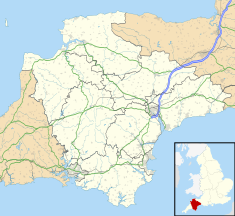
Newton Abbot is a market town and civil parish on the River Teign in the Teignbridge District of Devon, England. Its population was 24,029 in 2011, and was estimated at 26,655 in 2019. It grew rapidly in the Victorian era as the home of the South Devon Railway locomotive works. This later became a major steam engine shed, retained to service British Railways diesel locomotives until 1981. It now houses the Brunel industrial estate. The town has a race course nearby, the most westerly in England, and a country park, Decoy. It is twinned with Besigheim in Germany and Ay in France.
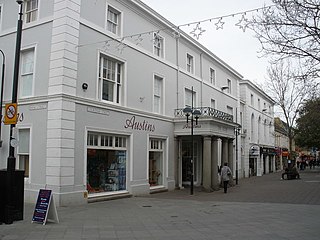
Austins is a department store in Newton Abbot, Devon. Founded in 1924 as a drapery shop the store has expanded to four locations in one part of the town which has been described as the "Austins Quarter". It is a major employer in the town and the largest independent store in South West England.
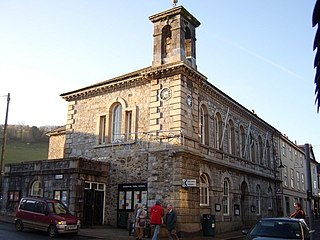
Ashburton Town Hall is a municipal building in the North Street, Ashburton, Devon, England. The town hall, which is the meeting place of Ashburton Town Council, is a Grade II listed building.

Hanley Town Hall is a municipal building in Albion Square in Hanley, Staffordshire, England. The building, which is used as the local register office, is a Grade II listed building.
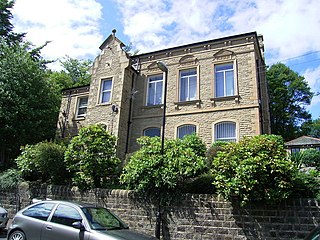
Slaithwaite Town Hall, also known as Empire House is a former municipal building in Lewisham Road in the town of Slaithwaite, West Yorkshire, England. The building, which served as the offices of Colne Valley Urban District Council, is now a business centre.

The McMillan Hall is a municipal building in Dashwood Square in Newton Stewart, Dumfries and Galloway, Scotland. The structure, which is used as a community events venue, is a Category B listed building.
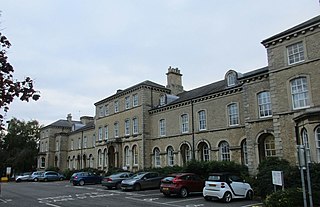
The North Kesteven Council Offices, formerly County Offices, Sleaford, is a municipal structure in Lafford Terrace, Sleaford, Lincolnshire, England. The structure, which is currently used as the headquarters of North Kesteven District Council, is a Grade II listed building.

Coldstream Town Hall is a municipal building in the High Street, Coldstream, Scottish Borders, Scotland. The structure, which currently accommodates a library and a registration office, is a Category B listed building.

The Old Council Offices are in Trevenson Street, Camborne, Cornwall, England. The building, which was used as the offices of Camborne-Redruth Urban District Council and is currently vacant, is a grade II listed building.

Monaghan Town Hall, is a municipal building in Dublin Street, Monaghan, County Monaghan, Ireland. The building is currently used by Monaghan County Council as local municipal offices.

Swadlincote Town Hall is a municipal building in The Delph in Swadlincote, a town in Derbyshire in England. The building, which serves a community events venue, is a Grade II listed building.

Felling Town Hall, formerly Felling Council Offices, is a former municipal building in Sunderland Road, Felling, a district of Gateshead, in Tyne and Wear, England. The building, which is currently in residential use, is a Grade II listed building.
Osborne House, formerly Cheadle Town Hall, is a former municipal building in Leek Road in Cheadle, Staffordshire, a town in England. The building retains the façade of the former town hall but has been extensively redeveloped for residential use behind the façade.
Frome Town Hall is a municipal building in Christchurch Street West in Frome, a town in Somerset, in England. It currently accommodates the offices and meeting place of Frome Town Council.
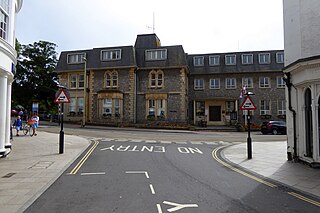
Exmouth Town Hall is a municipal building in St Andrews Road in Exmouth, a town in Devon, England. The building currently serves as the meeting place of Exmouth Town Council and also accommodates some staff from East Devon District Council.

The Old Town Hall is a historic building in the High Street in Crediton, a town in Devon in England. The structure, which was previously used as public events venue and currently accommodates the Crediton Museum, is a Grade II listed building.

Buckfastleigh Town Hall is a municipal building in Bossell Road in Buckfastleigh, a town in Devon, in England. It currently accommodates the offices and meeting place of Buckfastleigh Town Council.

The Old Town Hall is a former municipal building in New Street in Paignton, a town in Devon, in England. It served as the offices of Paignton Urban District Council until 1946, but was later converted for residential use.
The Old Town Hall Chambers is a historic building in the High Street in Newport Pagnell, a town in Buckinghamshire, in England. The building, which served as a public events venue, is a grade II listed building.

New Milton Town Hall is a municipal building in Ashley Road in New Milton, a town in Hampshire, in England. The building accommodates the offices and meeting place of New Milton Town Council.

